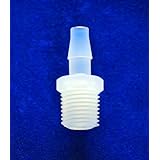I'm stumped on the benefit of doing this. In order to access the water, you either have to separate all of the bottles, else you have to use water pressure into bottle 1 to get water out of bottle 8. If you have water pressure at bottle 1, that negates the need for storing so many bottles of water. If you lose water pressure at bottle 1, and you're storing this for an emergency when you would be without water, then you'll have to disconnect all the bottles anyway - it would be less work in the long run to simply fill the bottles individually.
If you're doing this to, say, let water age and lose its chlorine for use in, say, aquariums, again, you may as well fill the bottles separately. As, if you use water pressure to move the water out, it's naive to think that the new water is going to fill the bottles one at a time, while pushing that volume of water on to the next bottle. In fact, if you turned on fresh water, you could have a current of the fresh water flowing out the last bottle within 1 gallon of water being added.
And, if you're going to use air pressure in the event of a power outage, as soon as the water level drops below the hose, you're going to be pushing air over a 3/4 filled bottle of water.
Maybe someone else can engineer a way around this, but I considered different lengths of hoses. If the "out" hose is near the bottom, then you can't force the air out that's above the opening of the hose. You'll simply end up with an inch of water in the bottle and pressurized air above it.
If the "out" hose is near the top, then you get a bottle of water, but there's no way to move the water from one bottle to the next without forcing more water through the system - if you force air through the system to push the water, it'll just bubble up to the "out" hose and the air will exit, leaving the water behind.






